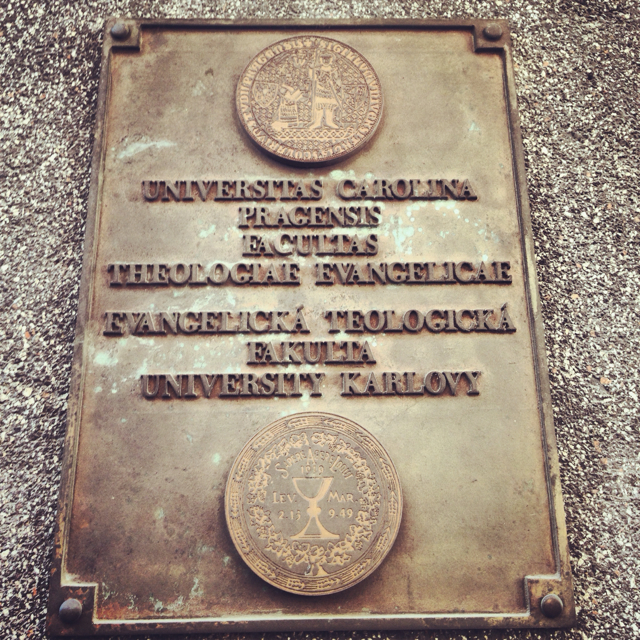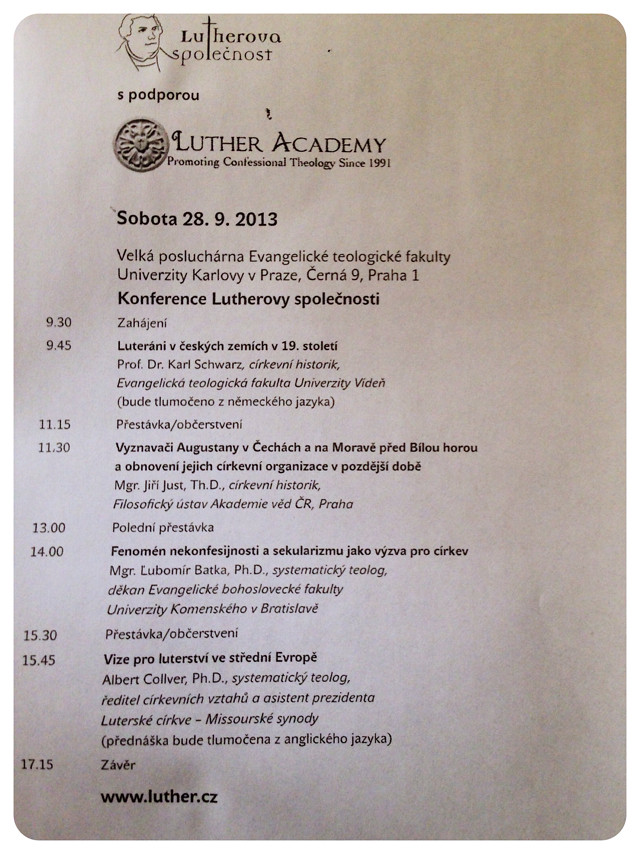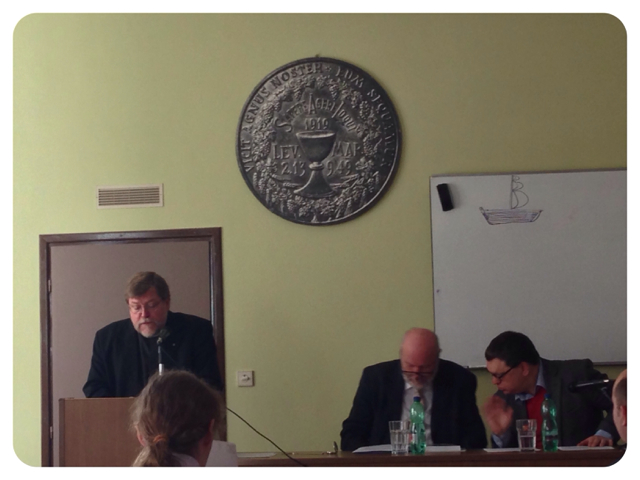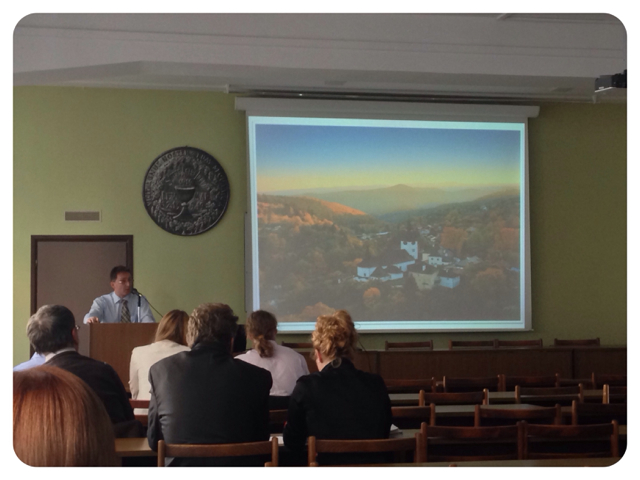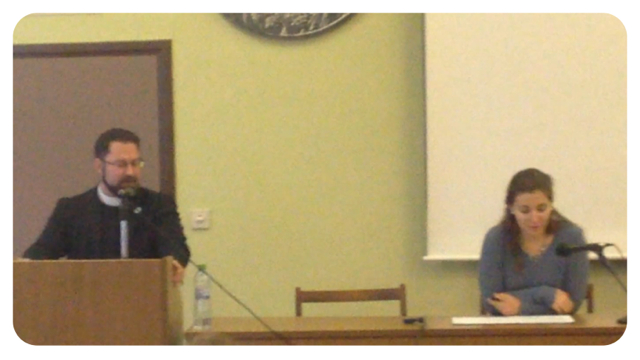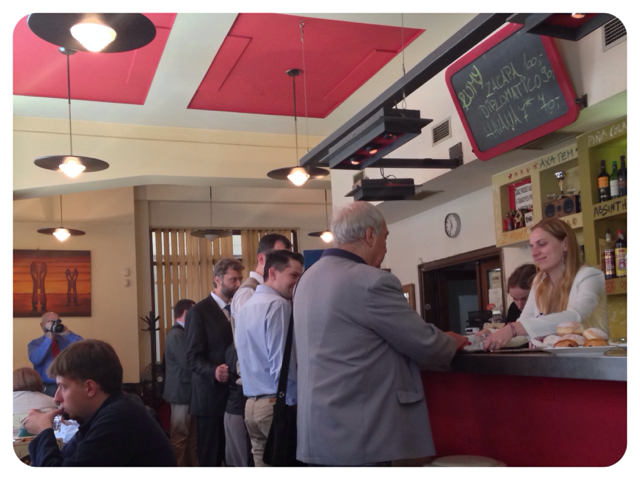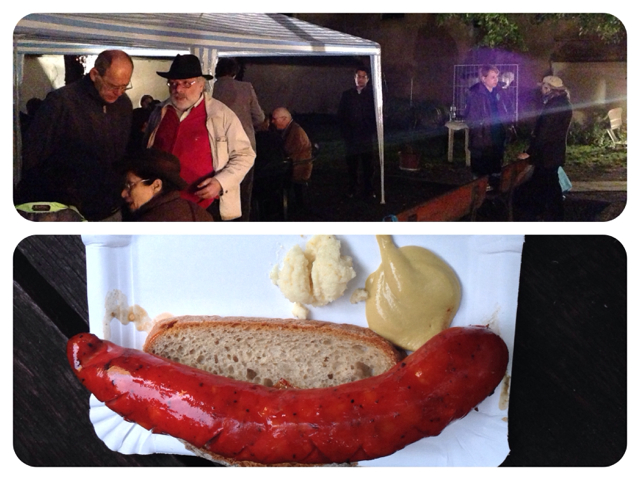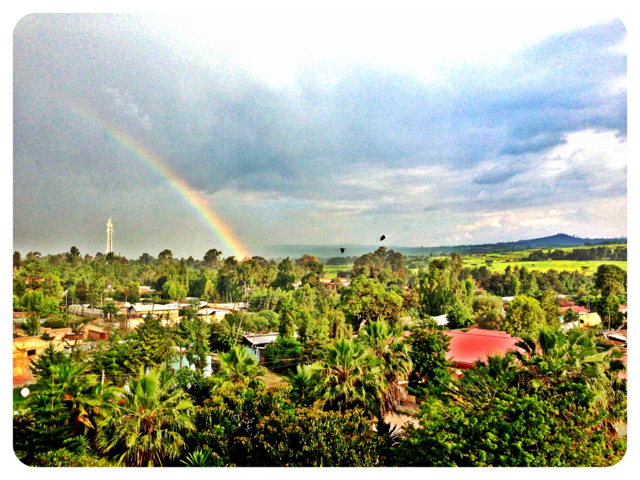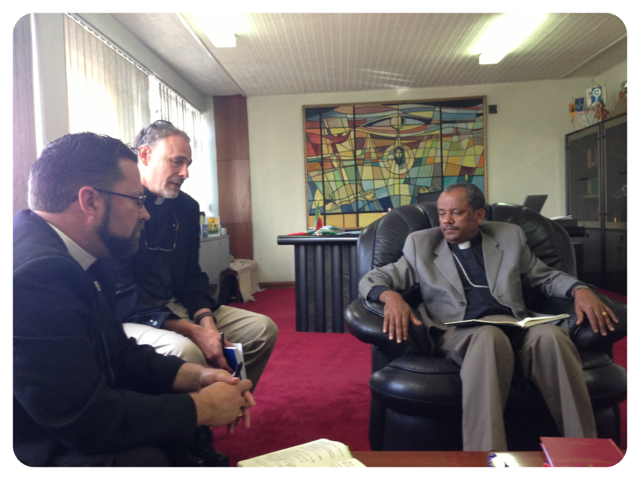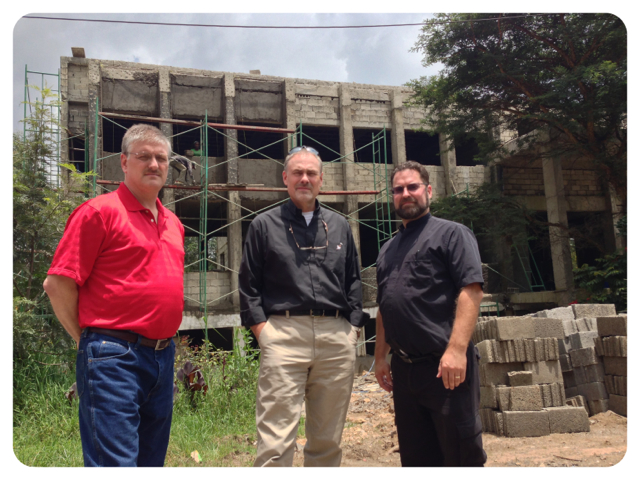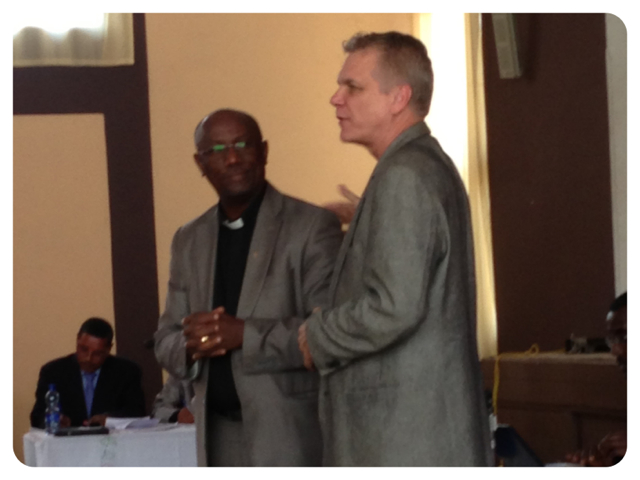The following article is a translation of "Kristův úřad ve světě" by Rev. James Krikava from Evangelicus, Reformation 2013, a publication of the Evangelical Church of the Augsburg Confession in the Czech Republic (ECAVvČR).
Christ’s Ministry to the
World
by Rev. James Krikava
As
the Evangelical Church of the Augsburg Confession in the Czech Republic (ECAVvČR)
celebrates the 20th anniversary of her founding, it is well for us to reflect
upon the many blessing bestowed upon her with thanksgiving to God, our Father,
whose love for fallen mankind so moved Him to send His only-begotten Son,
becoming true Man, yet very God, without sin, that He might redeem mankind by His
holy life and His atoning sacrifice upon the cross as the payment for the sins
of the world. By His victorious resurrection from the grave, by which all power
in heaven and on earth has been given to Him, Christ has established His
ministry of the Word, by which God the Holy Spirit creates and sustains faith
in the hearts of all believers and accomplishes His mission in the world. As
the foundational symbol, after which the ECAVvČR is named, says, “To obtain such faith God instituted the
office of the ministry, that is, provided the Gospel and the sacraments. Through
these, as through means, he gives the Holy Spirit, who works faith, when and
where he pleases, in those who hear the Gospel. And the Gospel teaches that we
have a gracious God, not by our own merits but by the merit of Christ, when we
believe this” (AC V:1-3). Indeed, this is what we who believe celebrate on
an anniversary occasion such as this.
But
as Christ was both God and Man in one person, so the ministry of the Spirit has
both a divine and human side to it. The divine side is clear, as St. Peter references
the prophet Isaiah, “‘The word of the
Lord remains forever.’ And this word is the Gospel that was preached to you” (1 Pt 1:25). This Gospel, which is preached to you,
while divine, is presented in a very human way, suited for our humanity. St.
Paul says, “We have this treasure in
earthen vessels, that the excellence of the power may be of God and not of us”
(2 Cor. 4:7). For “we are not sufficient
of ourselves to think of anything as being from ourselves, but our sufficiency
is from God, who
also made us sufficient as ministers of the New Testament, not of the letter
but of the Spirit; for the letter kills, but the Spirit gives life” (2 Cor 3:5-6). The letter that kills is the law, and “by the deeds of the law no flesh
will be justified in His sight, for by the law is the knowledge of sin” (Rm 3:20). But the Spirit that gives life is the Gospel,
that is, the forgiveness of sins, “that through this Man the
forgiveness of sins is preached to you; and by Him everyone who
believes is justified from all things from which you could not be justified by
the law” (Acts
13:38-39).
If
the very apostles of Christ could claim nothing as coming from themselves in
the mission of the Church, how much more must the Church in mission today make
this claim? This is a matter for sober contemplation as the Evangelical Church
of the Augsburg Confession looks back on 20 years of grace in the Czech
Republic. To this end, and as one who worked in this mission field, I have been
asked to reflect on the following questions: 1) In what condition
was the church when you came? (V jakém
stavu byla církev, když jsi do ní přišel?)
2) What emphases did you
bring to the church? (Jaké důrazy jsi do ni vnesl?) and 3) Can you explain the idea with which you guided the
church and the goal of the path toward which we have taken steps? (Můžeš vysvětlit ideu, se kterou jsi církev
směroval a cíl cesty, na kterou jsme nakročili?)
I. In what condition was the church
when you came?
No
doubt this question refers to the condition of the emerging ECAVvČR at its
inception. It was a chaotic time when only 3 years after the “Velvet
Revolution” Czechoslovakia found itself on the verge of a “Velvet Divorce,”
which would leave the Slovak Lutheran congregation in Prague organizationally
cut off from her mother church in the soon to be established Slovak Republic.
Ironically, the terms of the “divorce” included a grandfather clause, which
allowed the Slovak congregation in Prague to become registered as its own
Lutheran Church in the newly established Czech Republic. The congregation had
to act quickly in order to take advantage of the opportunity. A constitution
had to be hastily put together, which included the essential statement acknowledging
the Holy Scriptures as the very Word of God and the sole source of doctrine and
life in the church, and holding to all the Lutheran Confessions contained in
the Book of Concord because they are a correct exposition of Scripture regarding
the articles of faith treated therein. In my mind, that was the condition in
which I found the ECAVvČR when I came, the one condition without which it would
have been impossible to work together with blessing.
This,
however, was not the main question I was really asking myself at the time.
Before coming to Prague and finding a lone Slovak Lutheran congregation meeting
at St. Michael’s church in Jirchářích,
I had spent several years working in Plzeň
as a Lutheran missionary sent by a small American Lutheran Church known as the
Evangelical Lutheran Synod (ELS). It was founded in the 19th century
by Norwegian immigrants who settled in the American Mid-West. By the time I was
born in the mid 1950s this church was, for the most part, Americanized. That
is, it had made the transition from Norwegian to English as had the larger
Lutheran churches of German, Swedish and other ethnic extractions.
Still,
there were certain elements of ethnic heritage that seemed to cling to these
so-called American Lutheran churches. Some were innocent enough, like the
annual Lutefisk Festivals (cod fish preserved in lye with the distinct flavor
of soap) among the Scandinavian Lutherans or the Oktoberfest celebrated by the
Germans. But some were not so innocuous. During the 18th and 19th
centuries, when most of these Lutherans came to America the Lutheran Church was
imbued with the spirit of “Pietism,” a movement that began in the late 17th
century as a reaction against the dogmatism of the period of Lutheran Orthodoxy
following the Reformation era. To a great extent, what was imported to America by
the immigrants was a Lutheranism with a different spirit than Luther, Chemnitz,
and others, who solidified the Reformation faith with the Book of Concord of 1580.
What
came to America was a Lutheranism with an anti-clerical bent, stressing a universal
priesthood that could govern itself and was suspicious of the intellectualism
of the ordained clergy. Certain acts of piety were required as indispensible
signs of true faith. Lutheran Orthodoxy in matters of Christian doctrine was
construed as unloving and the errors of heterodox churches were met with a
sympathetic ear so long as “Christian piety” was evident. The training of
pastors in the traditional theological disciplines waned, giving more
prominence to devotional life and acts of piety. With the need to assimilate
into English, fluency in German and Latin became casualties of the great
melting pot of the new American culture, and with it the writings of Luther and
other important Lutheran Reformers were lost for generations.
By
this neglect, the preaching of the objective truths of Scripture in the form of
Law and Gospel, sin and grace, repentance and the forgiveness of sins, gave way
to subjectivism and its stress on the fruits of the Christian life over against
the objective truths of Scripture. And the chief article of the faith, the
doctrine of justification by faith alone without the deeds of the law (AC IV)
was pushed into the background enough that Lutherans found themselves embracing
the rugged individualism of Wesleyan Methodism or worse, incorporating reformed
hymns into Lutheran hymnals and eroding the old Lutheran liturgy at every turn,
including the removal of the Lord’s Supper from the regular Sunday service and
a rejection of Lutheran liturgical richness and ceremonial in favor of the
emotional appeal of American Reformed Revivalism.
Not
that there weren’t good Lutheran theologians who stood face to the wind against
these trends. There were. Men like Charles Porterfield Krauth struggled for a
rebirth of authentic Lutheranism in the pietistic environment of Lutheranism in
the eastern states. In the Mid-West men like Carl Ferdinand Wilhelm Walther,
the first president of the Lutheran Church - Missouri Synod, and Ulrik Vilhelm
Koren, the “patriarch of Norwegian American Lutherans,” played significant
roles in the renewal of Confessional Lutheranism among their German and Norwegian
immigrant flocks. A golden thread of orthodox men continued to weave its way
through the fabric of the American Lutheran landscape in the struggle for
authentic Lutheranism through the generations to come. But the wave that washed
onto the American shore was so great that no one escaped getting wet. We were
all baptized with the waters of pietism, some driven toward the subjectivism of
liberal theology by which the Scriptures and the Lutheran Confessions were made
to conform to the church’s pious self-consciousness rather than being informed
by them; others driven toward a legalistic Biblicism, by which Christ as the
center of all fell into obscurity, and with it much of the richness of Lutheran
theology and liturgical practice.
What
was needed was a fresh look at nascent Lutheranism, which might by-pass the
rationalism of liberal Lutheranism, the pietism of conservative Lutheranism,
and, to some extent, even the age of Lutheran orthodoxy. From the mid 20th
century this new kind of ad fontes approach
to understanding Lutheranism began to emerge. By the 1960s the American Edition
of Luther’s Works appeared with over 50 volumes in English, and over the
following decades important writings of Martin Chemnitz, the so-called “second
Martin” of the Reformation, were also published in English.
Pandora’s
Box had been opened, and just in time for my own theological formation as a
young student at our Lutheran theological faculty. The effect was revelatory.
Our class was privileged to study under some of the best minds of our synod’s
history. Most influential among them was the Rev. Dr. Bjarne W. Teigen, who
taught Symbolics, Liturgics, and Church History. Through his own research he
inspired his classes to look critically at the state of Lutheranism in America,
particularly in the area of sacramental theology, which heretofore had been
uncritically accepted from the 17th century Lutheran dogmaticians.
Dr. Teigen introduced us to significant modern Luther scholars such as the Rev.
Professor Dr. Hermann Sasse and his most prized student, the Rev. Dr. Tom G. A.
Hardt, among others. Their monumental research on Luther’s understanding of the
Lord’s Supper, together with Dr. Tiegen’s own research on the same in the
theology of Martin Chemnitz, perhaps more than anything else, revealed aspects
of pietism in the American Lutheran churches we called confessional, including
our own.
Being
part of this emerging critic of American Lutheranism in the light of renewed
Luther scholarship would prove to be of great value on the foreign mission
field. In the American parishes to which we were assigned after ordination, the
wheels of change turned ever so slowly. Attempts to heighten awareness of a
more prominent role of the sacraments in the life of God’s people were met with
resistance, and progress required methodical and evangelical patience. Not only
that, but the synodical leadership was inclined to defend the status quo driven
more by the traditions of Pietism tied to ethnic loyalty than by the renewed
study of Luther and the Confessions. It was an uphill battle, and still is.
So,
when then the Velvet Revolution took place in 1989, and our American Lutheran
Church sent me to Czechoslovakia to attempt mission work there, the question on
my mind was not: “In what condition was the ECAVvČR when I came?” but, “In what condition
was the American church when I came?”
Was she even theologically mature enough to carry out the noble task of
Lutheran mission work abroad? Or was she only capable of exporting her own
brand of Lutheranism, pietistic warts and all, to a new land?
II. What emphases did you
bring to the church?
In
the Czech mission field, beginning in Plzeň, there
was an opportunity to start afresh. Some of our new Czech friends were receiving
catechetical instruction and attending divine services. They had no knowledge
of the elements of Lutheran pietism we had left behind in America. We were free
to establish the kind of Lutheranism only slowly being revived at home. Some of
it was only outward, though not unimportant. The black Geneva gowns, commonly worn
by the clergy in American Lutheran parishes, along with the businessman’s suit
worn during the week, could be quietly packed away and exchanged for the
historic liturgical vestments in use during the Reformation and the daily clerical
uniform reflecting the preaching office (Predigtamt).
But
some of it touched the very prominence of the Gospel itself, the forgiveness of
sins, so richly found in nascent Lutheran practice. The so-called truncated
divine service or service of the Word without the Lord’s Supper, so common in
America, would never need to be mentioned, and love for the Sacrament of
Christ’s body and blood could be so instilled in new converts that to them it would seem contrary
to the gospel if it were absent from the service. The old rationalistic
harangue of American Lutheran pietism that frequent communion leads to taking
it for granted, or that, as long as the gospel is preached, absolution and the
sacrament are redundant and unnecessary, could be easily replaced by Luther’s
own catechesis concerning the means of grace. In his Short Order of Confession Before the Priest for the Common Man,
after the confession of sin, the petition for grace, and the absolution, the
pastor asks the penitent,
“Why
do you desire to receive the sacrament [of the altar]? Answer: Because I desire to strengthen my soul with God’s Word and
sign and to obtain grace. [Confessor]: But
have you not [already] found forgiveness of sins by the absolution? Answer: So what! I want to add the sign
of God to his Word. To receive God’s Word in many ways is so much better”
(Luther’s Works American Edition, vol. 53, p. 118, emphasis mine).
And in the
Smalcald Articles, Luther’s last will and testament to the church, his praise
of all of God’s means of grace is unmistakable:
“We shall now return to the Gospel, which offers
council and help against sin in more than one way, for God is
surpassingly rich in his grace: First, through the spoken word, by which
the forgiveness of sin (the peculiar function of the Gospel) is preached to the
whole world; second, through Baptism; third, through the holy Sacrament of the
Altar; fourth, through the power of the keys; and finally, through the mutual
conversation and consolation of brethren. Matt. 18, ‘Where two are gathered,’
etc.” (Smalcald Articles, Part III, IV. emphasis mine).
Nor
would we need to shrink from St. Paul’s admonition, “Test all things; hold fast what is good” (1 Thessalonians 5:21),
in matters pertaining to the conduct of the Lutheran mass. Without the pietistic
baggage of our past we could finally honestly confess with our Lutheran Fathers
at Augsburg:
“We are
unjustly accused of having abolished the Mass. Without boasting, it is manifest
that the Mass is observed among us with greater devotion and more earnestness
than among our opponents. Moreover, the people are instructed often and with
great diligence concerning the holy sacrament, why it was instituted, and how
it is to be used (namely, as a comfort for terrified consciences) in order that
the people may be drawn to the Communion and Mass. The people are also given
instruction about other false teaching concerning the sacrament. Meanwhile no
conspicuous changes have been made in the public ceremonies of the Mass, except
that in certain places German hymns are sung in addition to the Latin responses
for the instruction and exercise of the people. After all, the chief purpose of
all ceremonies is teach the people what they need to know about Christ”
(Augsburg Confesssion, Article XXIV:1-3, emphasis mine).
In Catechesis
the evangelical confessional could again be imagined, by simply teaching
article XI of the Augsburg Confession: “It is taught among us that private
absolution should be retained and not allowed to fall into disuse. However, in
confession it is not necessary to enumerate all trespasses and sins, for this
is impossible. Ps. 19:12, ‘Who can discern his errors?’” (Augsburg Confesssion,
Article XI:1-2). Even such innocent and lovely practices as adorning our
sanctuaries with a crucifix, portraying Christ among the people as being
crucified (cf. Galatians 3:1), or making the sign of the cross according to
Luther’s rubric for morning and evening prayers (cf. Small Catechism VII:1 and
4), lost as casualties of American Lutheran pietism, could be taught without
wondering if someone might accuse us of “Romanizing tendencies.” And the best
of Lutheran hymnody could be instilled in the ears of young and old, leaving
behind that not unsizable collection of Reformed hymns, so beloved by American
frontier Lutherans.
These
were some of the desired emphases for mission work in the Czech Republic. After
moving to Prague and getting involved with the ECAVvČR, a group of American
expatriates expressed their desire for Lutheran services in English, which we
were glad to do, but on the condition that our English services would be
modeled after the Divine Service of Word and Sacrament established in the Czech
congregation in Plzeň. The
reason for this condition was that one could expect that Czechs and Slovaks,
who understood English, might visit this service from time to time, and it
would be important for them to see that the English worship was the same,
especially because we also hoped to establish worship in Czech at St. Michael’s
as well. It occurred to me that from these expatriate’s American Lutheran background,
they might be shocked by the “high church” Lutheran liturgical practices revived
in the Czech Republic. To my surprise, the reaction was the opposite. They
welcomed such a service for its Confessional and liturgical richness,
especially considering that the Protestant alternatives for English worship in
Prague tended to be rather “low church” and un-Confessional.
The
Slovak congregation of the ECAVvČR had its own traditions, in many ways
reminiscent of my own upbringing in Scandanavian Lutheranism imported to
America via the Ritual of the Church of Denmark and Norway of 1685, yet
somewhat reduced over the years by its English recension. The Slovak worship
reflected Lutheranism of a similar age and style. It was unmistakably Lutheran
in its retention of the basic form of the Lutheran mass, a sung liturgy,
including the chanting of the Epistle and Gospel, which had long ago fallen
into disuse in America, and the retention of individual absolution with the
laying on of hands before communion. But the truncated service of the Word
without the Sacrament was well entrenched, with the Lord’s Supper being offered
only once a month. An increase in the frequency of communion, however, cannot
be compelled. It must come from the Christian desire for the Gospel of the
forgiveness of sins, of which both absolution and the sacrament are forms
established by Christ. As Luther says in his Brief Exhortation to Confession
[with individual absolution] before the Sacrament:
“In
short, we approve of no coercion … If you are a Christian, you should be glad
to run more than a hundred miles for confession, not under compulsion but
rather coming and compelling us [pastors] to offer it. For here the compulsion
must be inverted; we [pastors] must come under the command and you must come
into freedom. We compel no man, but allow ourselves to be compelled, just as we
are compelled to preach and administer the sacrament” (Large Catechism, Part
V:30-31).
III. Can you explain the
idea with which you guided the church and
the goal of the path toward
which we have taken steps?
As
in all mission work, foreign or domestic, the goal of Christ’s ministry to the
world is the same now as it was when He established it, saying: “All authority has been given to Me
in heaven and on earth. Go therefore and make disciples of all the nations,
baptizing them in the name of the Father and of the Son and of the Holy Spirit, teaching them to observe all things
that I have commanded you; and lo, I am with you always, even to the end of the age” (Matthew 28:18-20). “Thus
it is written, that the Christ should suffer and on the third day rise from the
dead,
and that repentance and forgiveness of sins shall be proclaimed
in his name to all nations”
(Luke 24:46-47). “Peace be with you. As
the Father has sent me, even so I am sending you … Receive the Holy Spirit. If you forgive the
sins of any, they are forgiven them; if you withhold forgiveness from any, it
is withheld” (John 20:21-23). And, “Take, eat, this is My Body, which is given
for you. Do this in remembrance of Me … Drink of it all of you. This cup is the
New Testament in My Blood, which is shed for you for the forgiveness of sins.
This do as often as you drink it in remembrance of me” (Matthew 26:26-28; Mark 14:22-24; Luke
22:17-20; I Corinthians 11:23-25).
This
is the ministry of the Gospel, instituted by Christ Himself, in the forms of
Word and Sacrament. These are means by which Christ still implants in the
hearts of His people the salvation he won for all mankind on the cross. These
create and sustain in the hearts of His people the faith, which alone justifies
the sinner before a just and holy God. As our chief symbol so clearly states:
“It
is also taught among us that we cannot obtain forgiveness of sin and
righteousness before God by our own merits, works, or satisfactions, but that
we receive forgiveness of sin and become righteous before God by grace, for
Christ’s sake, through faith, when we believe that Christ suffered for us and
that for his sake our sin is forgiven and righteousness and eternal life are
given to us. For God will regard and reckon this faith as righteousness, as
Paul says in Romans 3 and 4” (Augsburg Confession, Article IV).
This
faith cannot exist apart from the ministry of Christ. Indeed, it can be said
that Baptism, the preaching of Christ, Absolution, and the Sacrament of the
Altar are our justification by faith alone. For in them and by them this
justifying faith is created and sustained, which clings to Christ and His forgiveness
in them by faith alone. With Luther’s monumental rediscovery of this
all-important truth, the Church, which bears his name, has taken care to make
this ministry of Christ to the world a bright light by everything she does.
Over
the past 20 years of grace, the ECAVvČR has entered upon this path. But because
she has, she must all the more bear the warning of her own battle hymn, “A
Mighty Fortress is our God”: “The old evil foe now means deadly woe; deep guile
and great might are his dread arms in fight. On earth is not his equal” („Ten starý nepřítel zkazit by nás chtěl, moc a
mnohá lest hrozná zbraň jeho jest, v světě nemá rovného“) (Brněnský Kancionál
2012, č. 109:1). While
Christ alone is the “Valiant One” („rek udatný“) who “fights for us” („hájí nás“) and “holds the field for ever” („pole
jistě obdrží“) (Brněnský Kancionál
2012, č. 109:2), He does
this among us through His ministry of Word and Sacrament: “The Word they still
shall let remain nor any thanks have for it; He’s on our side upon the plain
with His good gifts and Spirit” („Ďábel,
svět musejí jistě ustoupit slovu jeho, neb s námi jest
v každém místě Pán s dary Ducha svého“) (Brněnský Kancionál
2012, č. 109:4, emphasis mine).
Therefore,
the ECAVvČR must look forward to the next 20 years of grace with the firm
conviction to be ever more Lutheran and never less. For, to be Lutheran is to
possess to the fullest the ministry of Christ to the world. As the American
General, George S. Patton was fond of quoting, “L'audace,
l'audace, toujours l'audace!” so the Lutheran Church, wherever she exists in
the world, must forge ahead boldly, remembering that every step forward is
propelled by a giant leap back to the Lutheran Reformation sources. On this 20th
anniversary may the ECAVvČR
treasure her Lutheran heritage and ever more make its treasures her own by letting
the Gospel have free course in all the churches through Christ’s Ministry of Word
and Sacrament.
“And God, who is rich in mercy, because
of His great love with which He loved us, even when we were dead in trespasses,
made us alive together with Christ (by grace you have been saved), and raised us up together, and made us sit together in the heavenly places in Christ Jesus, that
in the ages to come He might show the exceeding riches of His grace in His kindness toward us in Christ
Jesus. For by grace you have been saved through faith, and that
[faith] not of yourselves; it is
the gift of God, not of works, lest anyone should boast. For we are His
workmanship, created in Christ Jesus for good works, which God prepared
beforehand that we should walk in them” (Ephesians 2:4-10).
Soli
Deo Gloria!







